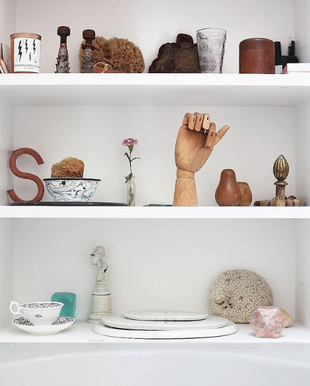- Tat London

- Jul 30, 2021
- 4 min read
Updated: Feb 15, 2023


If you are an avid reader of Tat (If? Ha!), you will have seen at some points through the year I drop a few lists of Airbnb's that I think are dead good. The Engine House appeared on the first Airbnb list. Now it's off Airbnb, but it's on Tat, which is very exciting. Sandy very kindly took on the Knock Knock challenge for this week, and I think it's a winner!

My mum and dad’s first home was a caravan on a farm. It was parked in a Nissan hut so there was no natural light but my mum, who worked as a pattern cutter, still ran up some blue-checked curtains for the windows. They babysat the farmer’s kids in return for hot baths. For two years they squirrelled away money to buy a bricks and mortar house – my childhood home. It was all 70s Victoriana, William Morris wallpaper, re-wired oil lights, a purple PVC covered Chesterfield and a lucky street find Victorian spiral staircase – painted in 70s brown gloss (Good Housekeeping 1975!). When mum felt the house was getting a bit cramped, she knocked down the kitchen wall, compelling my folks to get going on an extension. This time, the interior was proper modern 70s – a water bed, cork floor and lots of hanging spider plants. This year, both my sisters have building projects, so I’m beginning to think this stuff is in our blood...

In 2012 I came back to England after a few years in California, I think this return home heightened my nesting instinct and I started searching for a fixer-upper. The Engine House was the first place I looked at, found on a site I visited obsessively – Wreck Of The Week, run by Sue Greenwood. It was built to serve a local stately home, Barton Hall, with electricity. Two 20 horsepower oil-fuelled Hornsby Akroyd engines provided power for the hall but in 1914 there was a huge fire and the house was abandoned – and The Engine House became redundant. It fell into a very romantic state of dereliction until I bought it in 2014, 100 years after the fire. Through the years it was variously a forge, an artist’s studio and a fruit and veg plot and store – when I first visited, the walls were covered with the grocer’s pencilled calculations. Sadly these are now concealed, as an industrial building there was no cavity wall so an interior brick skin had to be built to sandwich in the insulation.

The project took a few years... from securing a mortgage, designing the renovation and extension (by my old friend, Michael Corsar), getting planning permission, the construction job itself to finally furnishing the house. The idea was to maintain as much of the feeling I had about the house when I first saw it, falling in love with the light, its double height and the beautiful brickwork. Because I collect/hoard stuff, it was important that the design and finish of the building were simple and uncluttered. The palette of materials is very reduced – just oak floors and panelling, white walls, concrete steps, reclaimed Victorian quarry tiles and large simple windows to let lots of light in. The wall lights sit pretty invisibly in the main space – they look like protruding bricks. I was weirdly obsessed by settles for some reason so Michael designed me a modern version, a lift-up bench which tidies away a bunch of stuff, the back of which is a clever wood store. It was a huge pleasure to work with a trusted and generous friend, he indulged me when my ideas sounded semi sensible and told me when I was being an idiot.

The decoration of the space has been very ad-hoc, it looks pretty coherent because it's just me that’s chosen everything but there was never really a plan. I’m a magpie and more acquisitive than I’d like, so I have too many chairs, jugs, candlesticks and lamps. I love moving stuff around and I love that a darning sampler from the 1700s sits happily next to a 1960s Shatterline lamp base and that ceramics by friends look at home sitting on a Georgian chest of drawers. In the main space, the two key things never jar even though they were made a good century apart – a pair of 1970s Hans Due, Optima pendant lights (bought from different sellers) and the Victorian quarry tiles – a bunch of abortive attempts at getting the original tiles up resulted in buying reclaimed ones. In the garden, Christophe Pillet ‘Round’ chairs from 2007 (bought from Paul’s Emporium) sit alongside a group of Willy Guhl planters from the 50s. As much as possible I furnished the house with old/second-hand stuff, from standard Ikea beds bought off Gumtree to two Niels Gammelgaard Ikea sofas from the 80s
(produced by a factory that made shopping trolleys). The chairs around the kitchen table were bought from Habitat by my parents in the 70s. There are concessions I’ve made to buying new stuff, both the wood burner and the bathroom sets are by Antonio Citterio but most of my stuff is from eBay, charity shops and flea markets. The irony of this isn’t lost on me, I come from a family of shopkeepers.
I feel incredibly lucky to have found The Engine House. It has been a properly joyful thing, from my first viewing of it when it was full of abandoned birds nests and cobwebs to finding really lovely local builders, to filling it with friends and family (and tut and a bit of Tat!) to the perversity of lockdown providing the time to spend in the space and feel the beauty of each season.

A Whopper Of A Thank You To Sandy, If You Are Interested In Renting The Engine House Click Here & Follow Them Here!






























Comments